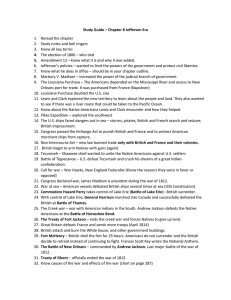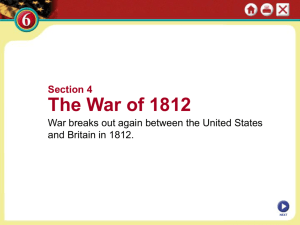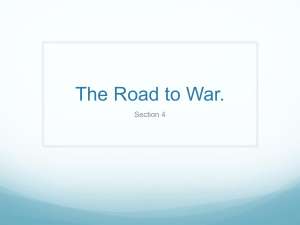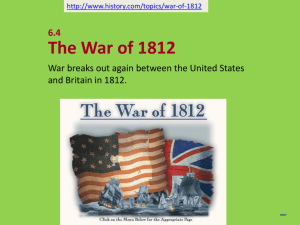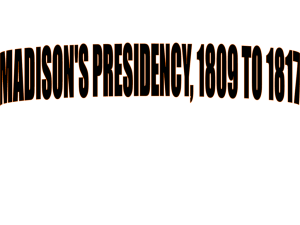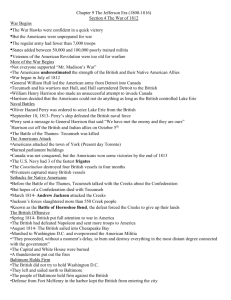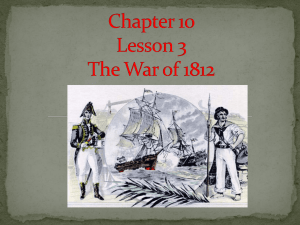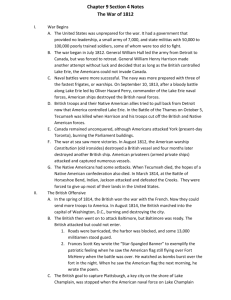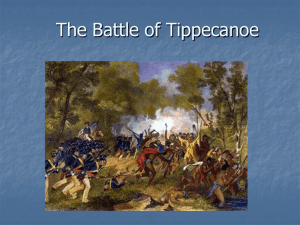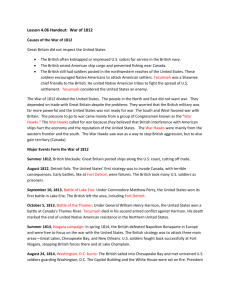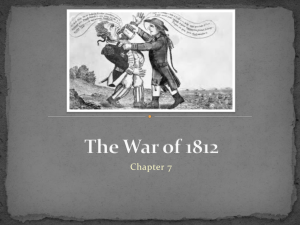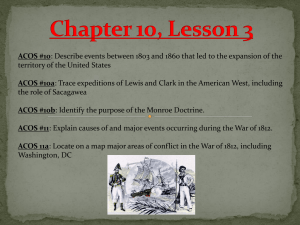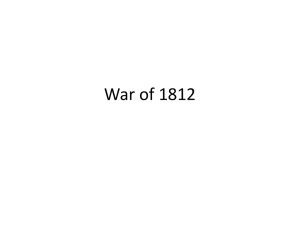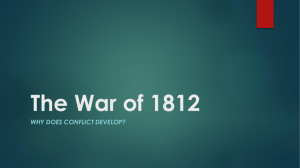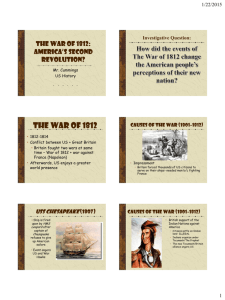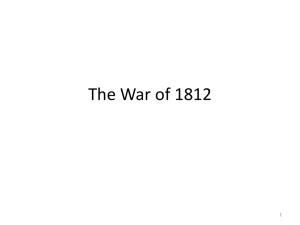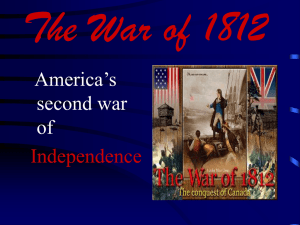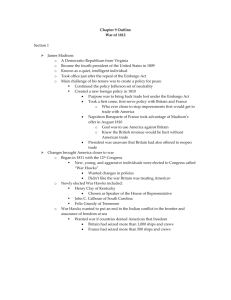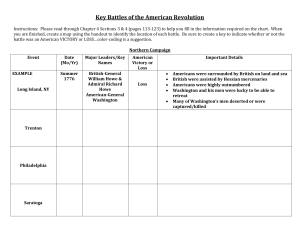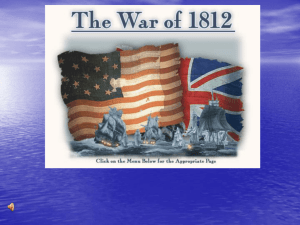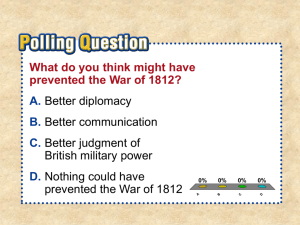War of 1812
advertisement
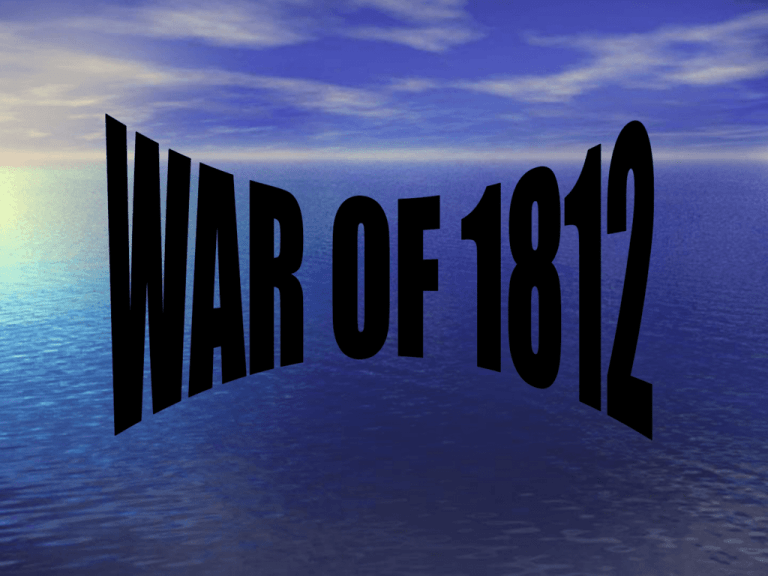
A. James Madison defeats Charles Pinckney to become the fourth President of the US. He was President Jefferson’s Secretary of State. A. Since 1803, a war between France and Great Britain reopens old problems when the two countries start the seizure of US merchant ships and the impressment of its crew into the British Navy. B. The US under C. Jefferson tried Embargos, which prohibits trade with another country. Unfortunately, it hurt the US economy and industry and was ineffective with Great Britain or France. A. Tecumseh and B. The Prophet, two brothers of the Shawnee tribe helped to unite a Confederacy of Native Americans. Tecumseh hoped to stop US settlers from taking any more of their land. C. Tecumseh was a D. commanding speaker that also possessed impressive political skills. The Native Americans began to renew contacts with British agents and fur traders in Canada. 1. In 1811 the Governor of the Indiana Territory, General William Henry Harrison, decided to attack the Tecumseh’s brother’s village known as Prophetstown. 2. After two hours of 3. 4. fighting, The Prophet’s forces fled the area in defeat. It was a great patriotic victory for the Americans. However, it resulted in Tecumseh allying himself with British troops. A. War Hawks were B. young Republicans from the South and West elected in 1810, that demanded a more aggressive policy against the British. Two of the leaders of the War Hawks were Henry Clay and John Calhoun. C. Using patriotism and D. E. nationalism, the war hawks heightened war fever throughout the nation. They hoped that war with Britain would bring more territorial gains in Canada and in Spanish Florida. Through Congress, the War Hawks quadrupled the size of the US Army. V. War is Declared A. For the 1st time the B. United States declares war against Great Britain on June 18, 1812. It would not be a quick war as the War Hawks expected. It lasted almost 3 years. C. The battles began in July 1812 with American Generals Hull and Harrison trying to take Canada, but would fail with the British in control of Lake Erie D. Oliver Hazard Perry, commander of the Lake Erie Naval Forces, was ordered to seize control of the lake from the British E. The Battle of Lake F. G. Erie happened on September 10, 1813. The bloody battle ended in victory for the Americans. Perry sent this to General Harrison: “We have met the enemy and they are ours.” VI. Victories for the US A. By the end of 1813, the US was winning battles on sea and on land. B. In the Battle of the Thames in October, Tecumseh was killed marking the eventual defeat of the Native American confederacy VII. British attack Washington D.C. A. On August 24, 1814, the British sailed up the Chesapeake Bay and attacked Washington D.C. B. British soldiers burned and destroyed everything associated with the government. C. The Capitol and the President’s Mansion were among the buildings burnt down. VIII. The Star-Spangled Banner A. After attacking D.C., the British head to Baltimore where 13,000 US militiamen were awaiting them. B. The militiamen and the bombardment from Fort McHenry allowed for the US to claim victory. C. Francis Scott Key, a young attorney, was moved by the victory and wrote a poem that would become our National Anthem: “The StarSpangled Banner.” IX. End of the War A. British General Prevost led 10,000 troops from Canada into New York. B. Their goal was to capture Plattsburg along Lake Champlain C. The British would retreat following the American Naval force defeating the British fleet in September. D. E. After the Battle of Lake Champlain, the British decided the war in North America was too costly and unnecessary. The US and Great Britain would sign the Treaty of Ghent (Belgium) in December of 1814 marking the end of the War of 1812. F. Word of the treaty being signed was late allowing for one final battle in New Orleans on January 8, 1815. G. The Americans won this short gruesome battle, killing hundreds of British soldiers. H. The Battle of New Orleans made Andrew Jackson a national hero and it propelled him to the Presidency in 1828.
